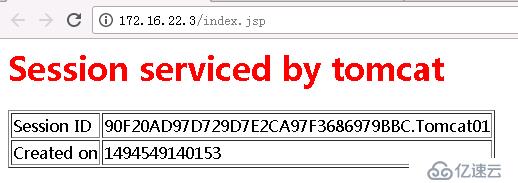жӮЁеҘҪпјҢзҷ»еҪ•еҗҺжүҚиғҪдёӢи®ўеҚ•е“ҰпјҒ
жӮЁеҘҪпјҢзҷ»еҪ•еҗҺжүҚиғҪдёӢи®ўеҚ•е“ҰпјҒ
жң¬зҜҮж–Үз« з»ҷеӨ§е®¶еҲҶдә«зҡ„жҳҜжңүе…іеҰӮдҪ•жҗӯе»әTomcat7 sessionеҗҢжӯҘйӣҶзҫӨпјҢе°Ҹзј–и§үеҫ—жҢәе®һз”Ёзҡ„пјҢеӣ жӯӨеҲҶдә«з»ҷеӨ§е®¶еӯҰд№ пјҢеёҢжңӣеӨ§е®¶йҳ…иҜ»е®ҢиҝҷзҜҮж–Үз« еҗҺеҸҜд»ҘжңүжүҖ收иҺ·пјҢиҜқдёҚеӨҡиҜҙпјҢи·ҹзқҖе°Ҹзј–дёҖиө·жқҘзңӢзңӢеҗ§гҖӮ
Tomcat sessionеҗҢжӯҘйӣҶзҫӨжҗӯе»ә
дёҖгҖҒеҰӮдҪ•дҝқжҢҒsessionдјҡиҜқ
дёәдәҶдҪҝwebиғҪйҖӮеә”еӨ§и§„жЁЎзҡ„и®ҝй—®пјҢйңҖиҰҒе®һзҺ°еә”з”Ёзҡ„йӣҶзҫӨйғЁзҪІгҖӮйӣҶзҫӨжңҖжңүж•Ҳзҡ„ж–№жЎҲе°ұжҳҜиҙҹиҪҪеқҮиЎЎпјҢиҖҢе®һзҺ°иҙҹиҪҪеқҮиЎЎз”ЁжҲ·жҜҸдёҖдёӘиҜ·жұӮйғҪжңүеҸҜиғҪиў«еҲҶй…ҚеҲ°дёҚеӣәе®ҡзҡ„жңҚеҠЎеҷЁдёҠпјҢиҝҷж ·жҲ‘们йҰ–е…ҲиҰҒи§ЈеҶіsessionзҡ„з»ҹдёҖжқҘдҝқиҜҒж— и®әз”ЁжҲ·зҡ„иҜ·жұӮиў«иҪ¬еҸ‘еҲ°е“ӘдёӘжңҚеҠЎеҷЁдёҠйғҪиғҪдҝқиҜҒз”ЁжҲ·зҡ„жӯЈеёёдҪҝз”ЁпјҢеҚійңҖиҰҒе®һзҺ°sessionзҡ„е…ұдә«жңәеҲ¶гҖӮ
еӣ дёәжҲ‘иҝҷиҫ№жҸҗдҫӣwebжңҚеҠЎзҡ„жҳҜдёӨеҸ°TomcatжңҚеҠЎеҷЁпјҢд№ҹдјҡжңүsessionе…ұдә«зҡ„и®®йўҳеӯҳеңЁпјҢз»ҸиҝҮдёҺејҖеҸ‘дәәе‘ҳзҡ„дәӨи°ҲдёӯдәҶи§ЈеҲ°пјҢ他们еә”з”Ёзҡ„sessionжҳҜз”ұJVMдә§з”ҹзҡ„пјҢжүҖд»ҘдёәдәҶи®©дёҖеҸ°tomcatжңҚеҠЎеҷЁеҮәзҺ°ж•…йҡңж—¶пјҢеҸҰеӨ–дёҖеҸ°еҸҜд»Ҙ继з»ӯжүҝжҺҘжңҚеҠЎпјҢ并дҝқжҢҒеҺҹе…ҲдјҡиҜқпјҢеҚіеңЁж•…йҡңжңҚеҠЎеҷЁдёҠеӨ„дәҺзҷ»е…ҘзҠ¶жҖҒзҡ„з”ЁжҲ·пјҢдёҚйңҖиҰҒеҶҚж¬Ўзҷ»е…ҘгҖӮ
дәҢгҖҒеңЁйӣҶзҫӨзі»з»ҹдёӢе®һзҺ°sessionз»ҹдёҖзҡ„жңүеҰӮдёӢдёүз§Қж–№жЎҲпјҡ
1гҖҒиҜ·жұӮзІҫзЎ®е®ҡдҪҚдә§з”ҹsessionзҡ„webжңҚеҠЎеҷЁпјҡsticky session,еҚіеҪ“еүҚз”ЁжҲ·зҡ„иҜ·жұӮйғҪйӣҶдёӯе®ҡдҪҚеҲ°дёҖеҸ°жңҚеҠЎеҷЁдёӯпјҢиҝҷеҸ°жңҚеҠЎеҷЁдҝқеӯҳдәҶз”ЁжҲ·зҡ„sessionзҷ»еҪ•дҝЎжҒҜпјҢеҰӮжһңе®•жңәпјҢ
еҲҷзӯүеҗҢдәҺеҚ•зӮ№йғЁзҪІпјҢдјҡдёўеӨұпјҢдјҡиҜқд№ҹдёҚдјҡеӨҚеҲ¶гҖӮ
#жіЁпјҡдёҠиҝ°жғ…еҶөйҖӮз”ЁдәҺеңЁwebз«ҜеҒҡеҘҪsessionе…ұдә«пјҢиҙҹиҪҪеқҮиЎЎеұӮеҒҡеҘҪsticky sessionпјҢеҲҷе°ұеҸҜд»Ҙе®һзҺ°зІҫеҮҶе®ҡдҪҚеҸҲе®һзҺ°и§ЈйҷӨж•…йҡңзҡ„жғ…еҶөгҖӮ
2гҖҒsessionеӨҚеҲ¶е…ұдә«пјҡsession replicationпјҢеҰӮtomcatиҮӘеёҰsessionе…ұдә«пјҢдё»иҰҒжҳҜжҢҮйӣҶзҫӨзҺҜеўғдёӢпјҢеӨҡеҸ°еә”з”ЁжңҚеҠЎеҷЁд№Ӣй—ҙеҗҢжӯҘsessionпјҢдҪҝsessionдҝқжҢҒдёҖиҮҙпјҢеҜ№еӨ–йҖҸжҳҺгҖӮ
еҰӮжһңе…¶дёӯдёҖеҸ°жңҚеҠЎеҷЁеҸ‘з”ҹж•…йҡңпјҢж №жҚ®иҙҹиҪҪеқҮиЎЎзҡ„еҺҹзҗҶпјҢи°ғеәҰеҷЁдјҡйҒҚеҺҶеҜ»жүҫеҸҜз”ЁиҠӮзӮ№пјҢеҲҶеҸ‘иҜ·жұӮпјҢз”ұдәҺsessionе·ІеҗҢжӯҘпјҢж•…иғҪдҝқиҜҒз”ЁжҲ·зҡ„sessionдҝЎжҒҜдёҚдјҡдёўеӨұпјҢе®һзҺ°дјҡиҜқеӨҚеҲ¶гҖӮ
дҪҶеҝ…йЎ»еңЁеҗҢдёҖз§Қдёӯй—ҙ件д№Ӣй—ҙе®ҢжҲҗ(еҰӮ:tomcat-tomcatд№Ӣй—ҙ).
sessionеӨҚеҲ¶еёҰжқҘзҡ„жҖ§иғҪжҚҹеӨұдјҡеҝ«йҖҹеўһеҠ .зү№еҲ«жҳҜеҪ“sessionдёӯдҝқеӯҳдәҶиҫғеӨ§зҡ„еҜ№иұЎ,иҖҢдё”еҜ№иұЎеҸҳеҢ–иҫғеҝ«ж—¶, жҖ§иғҪдёӢйҷҚжӣҙеҠ жҳҫи‘—пјҢдјҡж¶ҲиҖ—зі»з»ҹжҖ§иғҪгҖӮиҝҷз§Қзү№жҖ§дҪҝеҫ—webеә”з”Ёзҡ„ж°ҙе№іжү©еұ•еҸ—еҲ°дәҶйҷҗеҲ¶гҖӮ
SessionеҶ…е®№йҖҡиҝҮе№ҝж’ӯеҗҢжӯҘз»ҷжҲҗе‘ҳпјҢдјҡйҖ жҲҗзҪ‘з»ңжөҒйҮҸ瓶йўҲпјҢеҚідҫҝжҳҜеҶ…зҪ‘瓶йўҲпјҢеңЁеӨ§е№¶еҸ‘дёӢиЎЁзҺ°д№ҹ并дёҚеҘҪгҖӮ
#жіЁпјҡдёҠиҝ°2йҖӮз”ЁдәҺ并еҸ‘йҮҸе°Ҹзҡ„йӣҶзҫӨйңҖжұӮ
3.еҹәдәҺ memcache/redisзј“еӯҳзҡ„ session е…ұдә«
еҚідҪҝз”ЁcacheDBеӯҳеҸ–sessionдҝЎжҒҜпјҢеә”з”ЁжңҚеҠЎеҷЁжҺҘеҸ—ж–°иҜ·жұӮе°ҶsessionдҝЎжҒҜдҝқеӯҳеңЁcache DBдёӯпјҢеҪ“еә”з”ЁжңҚеҠЎеҷЁеҸ‘з”ҹж•…йҡңж—¶пјҢи°ғеәҰеҷЁдјҡйҒҚеҺҶеҜ»жүҫеҸҜз”ЁиҠӮзӮ№пјҢеҲҶеҸ‘иҜ·жұӮпјҢеҪ“еә”з”ЁжңҚеҠЎеҷЁеҸ‘зҺ°sessionдёҚеңЁжң¬жңәеҶ…еӯҳж—¶пјҢеҲҷеҺ»cache DBдёӯжҹҘжүҫпјҢеҰӮжһңжүҫеҲ°еҲҷеӨҚеҲ¶еҲ°жң¬жңәпјҢиҝҷж ·е®һзҺ°sessionе…ұдә«е’Ңй«ҳеҸҜз”ЁгҖӮ
дәҢгҖҒжң¬ж–Үдё»иҰҒ讲第дәҢз§ҚйӣҶзҫӨж–№ејҸпјҢй…ҚзҪ®еҹәдәҺtomcat7зҺҜеўғпјҢйҖҡиҝҮtomcatйӣҶзҫӨиҮӘеёҰзҡ„sessionеӨҚеҲ¶пјҢsessionдҝЎжҒҜе°Ҷдјҡиў«иҮӘеҠЁеӨҚеҲ¶еҲ°еҗ„дёӘиҠӮзӮ№гҖӮ
ж¶үеҸҠзҺҜеўғпјҡ
дё»жңә ж“ҚдҪңзі»з»ҹ IPең°еқҖ дё»иҰҒиҪҜ件
Nginx centos7.2 172.16.22.2 nginx-1.10.1
tomcat01 centos7.2 172.16.22.3 jdk-8u102-linux-x64.tar.gzгҖҒapache-tomcat-7.0.72.tar.gz
tomcat02 centos7.2 172.16.22.4 jdk-8u102-linux-x64.tar.gzгҖҒapache-tomcat-7.0.72.tar.gz
дёүгҖҒе®үиЈ…иҪҜ件е·ҘдҪң
1.е®үиЈ…Nginx
a.йҰ–е…Ҳе®үиЈқnginxеүҚйңҖиҰҒе®үиЈқдёҖдәӣдҫқиіҙеә« openssl-devel гҖҒzlib-devel гҖҒpcre-devel
[root@~]# yum install -y openssl-devel гҖҒzlib-devel гҖҒpcre-devel
еӣ дёәзЁӢеәҸй»ҳи®ӨжҳҜдҪҝз”Ё nobody иә«д»ҪиҝҗиЎҢзҡ„пјҢжҲ‘们дёәдәҶдҫҝдәҺжҹҘзңӢеҸҜд»ҘеҲӣе»әnginx з”ЁжҲ·жқҘиҝҗиЎҢпјҢйҰ–е…Ҳж·»еҠ nginxз»„е’Ңз”ЁжҲ·пјҢеҸҜдёҚеҲӣе»ә家зӣ®еҪ•пјҢ并且дёҚе…Ғи®ёзҷ»йҷҶзі»з»ҹ
[root@~]# groupadd nginx
[root@~]# useradd -M -s /sbin/nologin -g nginx nginx
b.и§ЈеҺӢnginx-1.10.1.tar.gzпјҢ并编иҜ‘
[root@~]# tar xf nginx-1.10.1.tar.gz
[root@~]# cd nginx-1.10.1
# ./configure \
--prefix=/data0/nginx \
--pid-path=/data0/nginx/logs/nginx.pid \
--lock-path=/var/lock/nginx.lock \
--user=nginx \
--group=nginx \
--with-http_ssl_module \
--with-http_flv_module \
--with-http_stub_status_module \
--with-http_gzip_static_module \
--http-client-body-temp-path=/var/tmp/nginx/client/ \
--http-proxy-temp-path=/var/tmp/nginx/proxy/ \
--http-fastcgi-temp-path=/var/tmp/nginx/fcgi/ \
--http-uwsgi-temp-path=/var/tmp/nginx/uwsgi \
--http-scgi-temp-path=/var/tmp/nginx/scgi \
--with-pcre
з»“жһңеҰӮдёӢпјҡ
Configuration summary
+ using system PCRE library
+ using system OpenSSL library
+ md5: using OpenSSL library
+ sha1: using OpenSSL library
+ using system zlib library
nginx path prefix: "/data0/nginx"
nginx binary file: "/data0/nginx/sbin/nginx"
nginx modules path: "/data0/nginx/modules"
nginx configuration prefix: "/data0/nginx/conf"
nginx configuration file: "/data0/nginx/conf/nginx.conf"
nginx pid file: "/data0/nginx/nginx.pid"
nginx error log file: "/data0/nginx/logs/error.log"
nginx http access log file: "/data0/nginx/logs/access.log"
nginx http client request body temporary files: "/var/tmp/nginx/client/"
nginx http proxy temporary files: "/var/tmp/nginx/proxy/"
nginx http fastcgi temporary files: "/var/tmp/nginx/fcgi/"
nginx http uwsgi temporary files: "/var/tmp/nginx/uwsgi"
nginx http scgi temporary files: "/var/tmp/nginx/scgi"
c.дёҠиҝ°й…ҚзҪ®е®ҢпјҢе°ұйҖІиЎҢз·ЁиӯҜе®үиЈқ
[root@~]# make && make install
[root@~]# mkdir /var/tmp/nginx/client/ -pv
зӯүзј–иҜ‘е®үиЈ…е®ҢжҲҗеҗҺеңЁ /data0 дёӢе°ұдјҡеҮәзҺ° nginx иҝҷдёӘзӣ®еҪ•дәҶпјҢиҝӣе…ҘиҝҷдёӘзӣ®еҪ•еҗҺеҸ‘зҺ°зӣ®еҪ•йқһеёёз®ҖеҚ•гҖӮ
е®ғзҡ„й…ҚзҪ®ж–Ү件еӯҳж”ҫеңЁ conf зӣ®еҪ•дёӯпјҢзҪ‘йЎөж–Ү件еӯҳж”ҫеңЁ html дёӯпјҢж—Ҙеҝ—ж–Ү件еӯҳж”ҫеңЁ logs дёӯпјҢ
sbin зӣ®еҪ•дёӢеҸӘжңүдёҖдёӘеҸҜжү§иЎҢзЁӢеәҸ "nginx"
d.иҝӣе…Ҙ/data0/nginx/conf,й…ҚзҪ®nginx.conf
й…ҚзҪ®nginx.confж–Ү件
[root@conf ] vim nginx.conf
user nginx;
#user root;
worker_processes auto;
error_log /data0/nginx/logs/error.log crit;
pid /data0/nginx/logs/nginx.pid;
worker_rlimit_nofile 100000;
events {
worker_connections 2048;
multi_accept on;
use epoll;
}
http {
include /data0/nginx/conf/mime.types;
default_type application/octet-stream;
server_tokens off;
sendfile on;
tcp_nopush on;
tcp_nodelay on;
keepalive_timeout 10;
client_header_timeout 10;
client_body_timeout 10;
reset_timedout_connection on;
send_timeout 10;
limit_conn_zone $binary_remote_addr zone=addr:5m;
limit_conn addr 100;
gzip_disable "msie6";
gzip_proxied any;
gzip_min_length 1000;
gzip_comp_level 6;
gzip_types text/plain text/css application/json application/x-javascript text/xml application/xml application/xml+rss text/javascript;
open_file_cache max=100000 inactive=20s;
open_file_cache_valid 30s;
open_file_cache_min_uses 2;
open_file_cache_errors on;
#load balance
upstream tomcat {
server 172.16.22.3:8080;
server 172.16.22.4:8080;
}
#load balance
server {
listen 80;
server_name localhost;
charset utf-8;
location ~ /uploads/.*\.(gif|jpg|jpeg|png|pdf|doc|xls|docx|xlsx|apk|htm|html|mp4|flv)$ {
expires 24h;
root /data0/nginx/res/home/;
access_log off;
proxy_store on;
proxy_store_access user:rw group:rw all:rw;
proxy_temp_path /data0/nginx/res/home/;
proxy_redirect off;
proxy_set_header Host $host;
proxy_set_header X-Real-IP $remote_addr;
proxy_set_header X-Forwarded-For $proxy_add_x_forwarded_for;
client_max_body_size 20m;
client_body_buffer_size 1280k;
proxy_connect_timeout 900;
proxy_send_timeout 900;
proxy_read_timeout 900;
proxy_buffer_size 40k;
proxy_buffers 40 320k;
proxy_busy_buffers_size 640k;
proxy_temp_file_write_size 640k;
if ( !-e $request_filename)
{
proxy_pass http://127.0.0.1:80;
}
}
location / {
client_max_body_size 20m;
proxy_pass http://localhost:8080/;
proxy_set_header Host $host;
proxy_set_header X-Real-IP $remote_addr;
proxy_set_header X-Forwarded-For $proxy_add_x_forwarded_for;
# allow 113.28.26.107
# deny all;
}
error_page 500 502 503 504 /50x.html;
location = /50x.html {
root html;
}
e.жЈҖжөӢй…ҚзҪ®ж–ҮжЎЈжҳҜеҗҰеҮҶзЎ®ж— иҜҜ
[root@~] # /data0/nginx/sbin/nginx -t
nginx: the configuration file /data0/work/nginx/conf/nginx.conf syntax is ok
nginx: configuration file /data0/work/nginx/conf/nginx.conf test is successful
#жіЁпјҡеҰӮжһңжңүй—®йўҳпјҢйҖҡиҝҮжҸҗзӨәеҶ…е®№иҝӣиЎҢи§ЈеҶіеҚіеҸҜ
f.еҗҜеҠЁnginxжңҚеҠЎ
[root@~] # /data0/nginx/sbin/nginx
g.дҪҶжҳҜиЁҳеҫ—й—ңй–үйҳІзҒ«зүҶжҲ–е°Ҷз«ҜеҸЈеҠ е…ҘйҳІзҒ«еўҷ规еҲҷ
еӣ дёәеңЁCentOS 7 д»ҘеҫҢдёҚеҶҚз”ЁiptablesдҪңзӮәйҳІзҒ«зүҶпјҢзӣҙжҺҘдҪҝз”Ёfirewall
[root@~]# systemctl stop firewalld.service && systemctl disable firewalld.service
жҲ–иҖ…
[root@~]# firewall-cmd --permanet --add-port=80/tcp
[root@~]# firewall-cmd --reload
h.жү“ејҖжөҸи§ҲеҷЁи®ҝй—®http://172.16.22.2жҲ–иҖ…еңЁжң¬жңәдҪҝз”Ё[root@~] curl http://localhost:80и®ҝй—®,еҰӮжһңиғҪжү“ејҖnginxй»ҳи®ӨзҪ‘йЎөеҮәзҺ°Welcome to nginxеӯ—ж ·пјҢеҲҷnginxе®үиЈ…жҲҗеҠҹ
2.е®үиЈқй…ҚзҪ®java иҲҮtomcat
a.еңЁе®үиЈқtomcatеүҚйңҖиҰҒе®үиЈқJava
и§ЈеЈ“дёҰдё”йҖІе…Ҙе®үиЈқеҢ…
[root@~]# tar -zxvf jdk-8u101-linux-x64.tar.gz
[root@~]# mkdir /usr/local/java
[root@~]mv jdk1.8.0_101/ /usr/local/java/
b.й…ҚзҪ®з’°еўғи®ҠйҮҸ
[root@~]# vim /etc/profile
еңЁжңҖеҗҺдёҖиЎҢж·»еҠ дёҠдёӢеҲ—дҝЎжҒҜ
# java
export JAVA_HOME=/usr/local/java/jdk1.8.0_101
export JRE_HOME=/usr/local/java/jdk1.8.0_101/jre
export CLASSPATH=.:$JRE_HOME/lib/dt.jar:$JRE_HOME/lib/tools.jar
export PATH=$JRE_HOME/bin:$JRE_HOME/bin:$PATH
c.и®“й…ҚзҪ®з”ҹж•ҲжҹҘзңӢзүҲжң¬
[root@~]# source /etc/profile
[root@~]# java -version
java version "1.8.0_101"
Java(TM) SE Runtime Environment (build 1.8.0_101-b13)
Java HotSpot(TM) 64-Bit Server VM (build 25.101-b13, mixed mode)
d.йҰ–е…ҲtomcatжҳҜдёҖеҖӢе…Қе®үиЈқи»ҹ件зӣҙжҺҘйҖІиЎҢи§ЈеЈ“еҚіеҸҜпјҢжҹҘзңӢtomcatзүҲжң¬еҸҠJVMй…ҚзҪ®з’°еўғдҝЎжҒҜ
[root@~]# tar -xf apache-tomcat-7.0.72.tar.gz
[root@~]# sh /data0/tomcat01/bin/version.sh
Using CATALINA_BASE: /data0/tomcat01
Using CATALINA_HOME: /data0/tomcat01
Using CATALINA_TMPDIR: /data0/tomcat01/temp
Using JRE_HOME: /usr/local/java/jdk1.8.0_101/jre
Using CLASSPATH: /data0/tomcat01/bin/bootstrap.jar:/data0/tomcat01/bin/tomcat-juli.jar
Server version: Apache Tomcat/7.0.72
Server built: Sep 14 2016 12:12:26 UTC
Server number: 7.0.72.0
OS Name: Linux
OS Version: 3.10.0-327.el7.x86_64
Architecture: amd64
JVM Version: 1.8.0_101-b13
JVM Vendor: Oracle Corporation
e.еҗҜеҠЁtomcatжңҚеӢҷ
[root@~]# sh /data0/tomcat01/bin/startup.sh
f.жҹҘзңӢжҳҜеҗҰй–Ӣж”ҫдәҶtomcatз«ҜеҸЈ 8080 8009 8005,жңҚеҠЎжҳҜеҗҰжӯЈеёё
[root@~]# netstat -nltp
Active Internet connections (only servers)
Proto Recv-Q Send-Q Local Address Foreign Address State PID/Program name
tcp 0 0 0.0.0.0:8009 0.0.0.0:* LISTEN 9844/java
tcp 0 0 0.0.0.0:8080 0.0.0.0:* LISTEN 9844/java
tcp 0 0 0.0.0.0:80 0.0.0.0:* LISTEN 32434/nginx: master
tcp 0 0 127.0.0.1:8005 0.0.0.0:* LISTEN 9844/java
3.е‘ҲзҺ°и®ҝй—®жөӢиҜ•sessionйЎөйқўзҡ„еҮҶеӨҮе·ҘдҪң
еңЁдёҠиҝ°жӯҘйӘӨе®ҢжҜ•еҗҺпјҢдҫҝдҝ®ж”№tomcatй…ҚзҪ®ж–Ү件
a.жіЁпјҡи®ҫзҪ®й»ҳи®Өдё»жңәпјҢ并еўһеҠ jvmRoute
[root@~]# vim /data0/tomcat01/conf/server.xml
жүҫеҲ°з¬¬102иЎҢ
102 <!-- You should set jvmRoute to support load-balancing via AJP ie :
103 <Engine name="Catalina" defaultHost="localhost" jvmRoute="jvm1">
104 -->
еңЁдёӢйқўж·»еҠ дёӢеҲ—еҶ…е®№пјҢиҜҘjvmRouteж”№дёәTomcat01
еҰӮпјҡ <Engine name="Catalina" defaultHost="localhost" jvmRoute="Tomcat01">
зӣ®зҡ„жҳҜдёәдәҶеңЁдҪҝз”ЁиҙҹиҪҪеқҮиЎЎеұӮи®ҝй—®йЎөйқўж—¶пјҢдәҶи§ЈжүҝжҺҘжңҚеҠЎзҡ„жҳҜе“ӘдёҖеҸ°tomcatжңҚеҠЎеҷЁ
#жіЁпјҡtomcat02д№ҹжҳҜиҝҷд№ҲеҒҡпјҢеҸӘжҳҜjvmRouteдёҚеҗҢпјҢеҸӘиҰҒжҠҠTomcat01жӣҙжҚўжҲҗTomcat02еҚіеҸҜ
b.еңЁеҸ‘еёғж–ҮжЎЈзӣ®еҪ•еҶ…ж·»еҠ жөӢиҜ•ж–Ү件
[root@~]# vim /data0/tomcat01/webapps/ROOT/jsp/index.jsp
<%@page language="java" import="java.util.*" pageEncoding="UTF-8"%>
<html>
<head>
<title>tomcat01</title>
</head>
<body>
<h2><font color="red">Session serviced by tomcat </font></h2>
<table aligh="center" border="1">
<tr>
<td>Session ID </td>
<td><%=session.getId() %></td>
<% session.setAttribute("abc","adc");%>
</tr>
<tr>
<td>Created on</td>
<td><%=session.getCreationTime() %></td>
</tr>
</table>
</body>
<html>
#жіЁ:еҸҰеӨ–Tomcat02иҠӮзӮ№дёҺtomcat01иҠӮзӮ№й…ҚзҪ®еҹәжң¬зұ»дјјпјҢеҸҰеӨ–дёәдәҶеҢәеҲҶз”ұе“ӘдёӘиҠӮзӮ№жҸҗдҫӣи®ҝй—®пјҢжөӢиҜ•йЎөж Үйўҳд№ҹдёҚеҗҢгҖӮе…¶д»–зҡ„й…ҚзҪ®йғҪзӣёеҗҢ
c.йҮҚеҗҜtomcatжңҚеҠЎпјҢеҲҶеҲ«иҝӣиЎҢжөӢиҜ•и®ҝй—®index.jsp
и®ҝй—®Tomcat01жөӢиҜ•йЎөйқў

и®ҝй—®Tomcat02жөӢиҜ•йЎөйқў

еҸҜд»ҘзңӢеҲ°и®ҝй—®з»“жһңдёӯйЎөйқўе‘ҲзҺ°зҡ„session ID дёҚеҗҢпјҢеҲ°иҝҷпјҢеҸҜд»ҘиҜҙеҮҶеӨҮе·ҘдҪңе°ұеҹәжң¬е®ҢжҲҗпјҢдёӢйқўжҲ‘们жқҘй…ҚзҪ®tomcatзҡ„иҙҹиҪҪеқҮиЎЎпјҢйҖҡиҝҮsessionеӨҚеҲ¶е®һзҺ°дјҡиҜқдҝқжҢҒгҖӮ
4.й…ҚзҪ®tomcatйӣҶзҫӨзҺҜеўғпјҡ
й…ҚзҪ®дјҡиҜқе…ұдә«йӣҶзҫӨпјҢеҲҶеҲ«еңЁtomcat01е’Ңtomcat02е®ҢжҲҗдёӢйқўзҡ„ж“ҚдҪң
a.й…ҚзҪ®server.xmlж–Ү件
[root@~]# vim /data0/tomcat01/conf/server.xml
жүҫеҲ°110иЎҢе·ҰеҸі
110 <!--
111 <Cluster className="org.apache.catalina.ha.tcp.SimpleTcpCluster"/>
112 -->
еңЁдёӢйқўж·»еҠ дёӢеҲ—еҶ…е®№:
<Cluster className="org.apache.catalina.ha.tcp.SimpleTcpCluster"
channelSendOptions="8" >
<Manager className="org.apache.catalina.ha.session.DeltaManager"
expireSessionsOnShutdown="false"
notifyListenersOnReplication="true"/>
<Channel className="org.apache.catalina.tribes.group.GroupChannel">
<Membership className="org.apache.catalina.tribes.membership.McastService"
address="228.0.0.4"
port="45564"
frequency="500"
dropTime="3000"/>
<Receiver className="org.apache.catalina.tribes.transport.nio.NioReceiver"
address="auto"
port="4000"
autoBind="100"
selectorTimeout="5000"
maxThreads="6"/>
<Sender className="org.apache.catalina.tribes.transport.ReplicationTransmitter">
<Transport className="org.apache.catalina.tribes.transport.nio.PooledParallelSender"/>
</Sender>
<Interceptor className="org.apache.catalina.tribes.group.interceptors.TcpFailureDetector"/>
<Interceptor className="org.apache.catalina.tribes.group.interceptors.MessageDispatch25Interceptor"/>
</Channel>
<Valve className="org.apache.catalina.ha.tcp.ReplicationValve"
filter=".*\.gif|.*\.js|.*\.jpeg|.*\.jpg|.*\.png|.*\.htm|.*\.html|.*\.css|.*\.txt"/>
<Valve className="org.apache.catalina.ha.session.JvmRouteBinderValve"/>
<Deployer className="org.apache.catalina.ha.deploy.FarmWarDeployer"
tempDir="/tmp/war-temp/"
deployDir="/tmp/war-deploy/"
watchDir="/tmp/war-listen/"
watchEnabled="false"/>
<ClusterListener className="org.apache.catalina.ha.session.JvmRouteSessionIDBinderListener"/>
<ClusterListener className="org.apache.catalina.ha.session.ClusterSessionListener"/>
</Cluster>
#дёҠиҝ°ж·»еҠ йӣҶзҫӨзҡ„еҶ…е®№жқҘиҮӘдәҺе®ҳзҪ‘й…ҚзҪ®ж–ҮжЎЈпјҢиҜ·еҸӮиҖғпјҡhttp://tomcat.apache.org/tomcat-7.0-doc/cluster-howto.html
b.й…ҚзҪ®еә”з”Ёд»Јз Ғзӣ®еҪ•дёӢзҡ„web.xmlж–Ү件
дҝ®ж”№еә”з”Ёзҡ„web.xmlж–Ү件пјҢеҠ е…Ҙж Үзӯҫ<distributable/>пјҢиҝҷжҳҜtomcatйӣҶзҫӨе®һзҺ°sessionеӨҚеҲ¶зҡ„зҡ„е…ій”®пјҢеҰӮжһңжІЎжңүж·»еҠ пјҢTomcatйӣҶзҫӨеҸҜд»ҘиҜҙе°ұж— жі•е®һзҺ°гҖӮи®ҫзҪ®еҫҲз®ҖеҚ•еҰӮдёӢжүҖзӨәпјҡ
[root@~]# vim /data0/tomcat01/webapps/ROOT/WEB-INF/web.xml
<welcome-file>index.shtml</welcome-file>
<welcome-file>index.jspx</welcome-file>
</welcome-file-list>
<distributable/> --ж·»еҠ зҡ„
</web-app>
#жіЁпјҡзӣҙжҺҘеҠ еңЁ</web-app>д№ӢеүҚе°ұеҸҜд»ҘдәҶгҖӮ
c.дёӨеҸ°TomcatеқҮжҢүдёҠиҝ°жӯҘйӘӨдҝ®ж”№дәҶй…ҚзҪ®ж–ҮжЎЈеҗҺпјҢжҲ‘们йҮҚеҗҜдёӢдёӨеҸ°TomcatжңҚеҠЎеҷЁпјҢ并йҖҡиҝҮжөҸи§ҲеҷЁи®ҝй—®jspжөӢиҜ•йЎөйқў
жҲ‘们йҮҚеҗҜдёӢдёӨеҸ°TomcatжңҚеҠЎеҷЁTomcatжңҚеҠЎ
tomcat02йҮҚеҗҜTomcatжңҚеҠЎ
[root@~]#sh /data0/tomcat02/bin/shutdown.sh
[root@~]#sh /data0/tomcat02/bin/startup.sh
еҶҚеҜ№tomcat01йҮҚеҗҜTomcatжңҚеҠЎ
[root@~]#sh /data0/tomcat01/bin/shutdown.sh
[root@~]#sh /data0/tomcat01/bin/startup.sh
жҹҘзңӢе…ҲеҗҜеҠЁйӮЈеҸ°жңәеҷЁдёҠзҡ„catalina.outж—Ҙеҝ—
[root@tomcat02 ~]# tail -f /data0/work/tomcat02/logs/catalina.out
May 11, 2017 11:46:29 AM org.apache.catalina.ha.tcp.SimpleTcpCluster memberAdded
INFO: Replication member added:org.apache.catalina.tribes.membership.MemberImpl[tcp://{172, 16, 22, 3}:4000,{172, 16, 22, 3},4000, alive=1011, securePort=-1, UDP Port=-1, id={-66 109 3 57 13 98 70 60 -86 23 -103 16 91 -52 -91 -49 }, payload={}, command={}, domain={}, ]
д»ҺдёҠйқўзҡ„SimpleTcpCluster memberAddedжқҘзңӢtomcat01е’Ңtomcat02жҲҗдәҶйӣҶзҫӨжҲҗе‘ҳдәҶгҖӮ
然еҗҺи®ҝй—®иҙҹиҪҪеқҮиЎЎеұӮзҡ„жөӢиҜ•йЎөйқў

еҲ·ж–°пјҢеҶҚзңӢжөӢиҜ•йЎөйқў

еӨ§е®¶еҸҜд»Ҙд»ҺеӣҫдёӯзңӢеҲ°пјҢдёҚз®ЎдҪ жҖҺд№ҲеҲ·ж–°SessionIDйғҪдёҚдјҡеҸҳпјҢеҸӘжңүжүҝиҪҪзҡ„жңҚеҠЎеҷЁеңЁеҸҳеҢ–иҖҢе·ІпјҢд»ҺиҖҢиҜҙжҳҺжҲ‘们зҡ„Tomcatзҡ„DeltaManagerйӣҶзҫӨй…ҚзҪ®е®ҢжҲҗпјҢе®һзҺ°дәҶдјҡиҜқе…ұдә«гҖӮ
д»ҘдёҠе°ұжҳҜеҰӮдҪ•жҗӯе»әTomcat7 sessionеҗҢжӯҘйӣҶзҫӨпјҢе°Ҹзј–зӣёдҝЎжңүйғЁеҲҶзҹҘиҜҶзӮ№еҸҜиғҪжҳҜжҲ‘们ж—Ҙеёёе·ҘдҪңдјҡи§ҒеҲ°жҲ–з”ЁеҲ°зҡ„гҖӮеёҢжңӣдҪ иғҪйҖҡиҝҮиҝҷзҜҮж–Үз« еӯҰеҲ°жӣҙеӨҡзҹҘиҜҶгҖӮжӣҙеӨҡиҜҰжғ…敬иҜ·е…іжіЁдәҝйҖҹдә‘иЎҢдёҡиө„и®Ҝйў‘йҒ“гҖӮ
е…ҚиҙЈеЈ°жҳҺпјҡжң¬з«ҷеҸ‘еёғзҡ„еҶ…е®№пјҲеӣҫзүҮгҖҒи§Ҷйў‘е’Ңж–Үеӯ—пјүд»ҘеҺҹеҲӣгҖҒиҪ¬иҪҪе’ҢеҲҶдә«дёәдё»пјҢж–Үз« и§ӮзӮ№дёҚд»ЈиЎЁжң¬зҪ‘з«ҷз«ӢеңәпјҢеҰӮжһңж¶үеҸҠдҫөжқғиҜ·иҒ”зі»з«ҷй•ҝйӮ®з®ұпјҡis@yisu.comиҝӣиЎҢдёҫжҠҘпјҢ并жҸҗдҫӣзӣёе…іиҜҒжҚ®пјҢдёҖз»ҸжҹҘе®һпјҢе°Ҷз«ӢеҲ»еҲ йҷӨж¶үе«ҢдҫөжқғеҶ…е®№гҖӮ